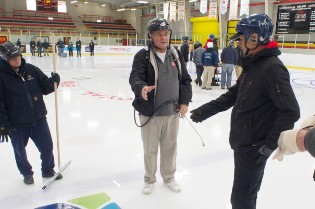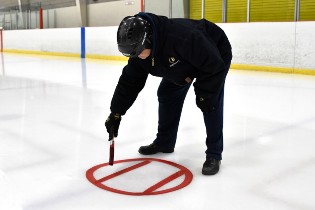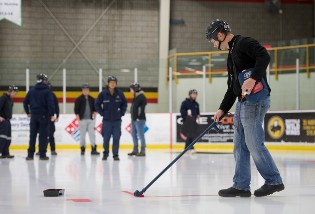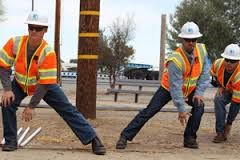- ORFA Home
- Resource Centre
- Guidelines/Best Practices
- Ice Arena Operations
- The Paint Stick
ORFA - Guidelines & Best Practices
The Paint Stick – Ergonomic Ice Technician Tool
ISSUE DATE: JULY 2019
COPYRIGHT © 2019 ONTARIO RECREATION FACILITIES ASSOCIATION INC.
DISCLAIMER: While the Ontario Recreation Facilities Association Inc. (ORFA) does its best to provide useful general information and guidance on matters of interest to its members, statutes, regulations and the common law continually change and evolve, vary from jurisdiction to jurisdiction, and are subject to differing interpretations and opinions. The information provided by the ORFA is not intended to replace legal or other professional advice or services. The information provided by the ORFA herein is provided “as is” and without any warranty, either express or implied, as to its fitness, quality, accuracy, applicability or timeliness. Before taking any action, consult an appropriate professional and satisfy yourself about the fitness, accuracy, applicability or timeliness of any information or opinions contained herein. The ORFA assumes no liability whatsoever for any errors or omissions associated with the information provided herein and furthermore assumes no liability for any decision or action taken in reliance on the information contained in these materials or for any damages, losses, costs or expenses in any way connected to it.
The Paint Stick Revolutionized the Ice Industry and is Now Considered a Leading Ergonomic Ice Technician Tool

Jet Ice Vice-President, Dave Loverock, has painted a significant amount of sporting ice in his 35+years in the industry. Most of his early career was spent bent over, hand painting, in a very cold environment; and his back reminds him everyday what he did for a living. This experience, as well as being mentored by Jet Ice founder Doug Moore to always look for new ways to do things more efficiently and professionally, put Dave on a quest to design an ice painting marking system that was more ergonomically correct while significantly improving an ice technician’s productivity during the ice painting process.
Research and development on this equipment was not seamless as a variety of different designs were explored and shelved long before the current equipment was produced. In the end, the Jet Ice paint stick has decreased the time to paint ice surface sport markings by 50%.
Worker Health Hazards of Painting Ice
Repetitive Strain Injury (RSI), also called musculoskeletal injuries or disorders (MSIs or MSDs), typically affect tendons, muscles, nerves and joints in the neck, shoulders and upper back; hips, knees and feet; elbows, forearms and hands. The highest risk factors to injury are often a lack of training and age. Ice painting is a task that is usually only undertaken once every season. The original ice marking painting process involved a paint brush and a worker being bent over for long periods of time. A young back will typically absorb the strain and heal quickly while as an ice technician ages, if they do not properly prepare for the task at hand, they could significantly injure themselves. When workers fail to have the right knowledge base and/or tools they will slowly begin to adjust their body position to relieve the discomfort. Often this will find them kneeling, sitting and at times even laying on the cold ice to get the job done in as little pain as possible. Painting ice indoors has some risk, however, painting ice outdoors can be a significantly higher risk factor.
 Workers must be informed that the cooling of body parts by improper positioning or inadequate personal protection may result in various cold injuries. Toes, fingers, ears and nose are at greatest risk because these areas do not have major muscles to produce heat. In addition, the body will preserve heat by favouring the internal organs and thus reducing the flow of blood to the extremities under cold conditions. Hands and feet tend to get cold more quickly than the torso because they have a higher surface area-to-volume ratio and they are more likely to be in contact with colder surfaces than other parts of the body. The most severe cold injury is hypothermia which occurs from excessive loss of body heat and the consequent lowering of the inner core temperature (internal temperature of the body).
Workers must be informed that the cooling of body parts by improper positioning or inadequate personal protection may result in various cold injuries. Toes, fingers, ears and nose are at greatest risk because these areas do not have major muscles to produce heat. In addition, the body will preserve heat by favouring the internal organs and thus reducing the flow of blood to the extremities under cold conditions. Hands and feet tend to get cold more quickly than the torso because they have a higher surface area-to-volume ratio and they are more likely to be in contact with colder surfaces than other parts of the body. The most severe cold injury is hypothermia which occurs from excessive loss of body heat and the consequent lowering of the inner core temperature (internal temperature of the body).
Pulled Back Muscle and Lower Back Strain
 The sciatic nerve is the largest nerve in the body. Sciatica pain is typically felt from the low back to behind the thigh and radiating down below the knee. A muscle strain happens when the muscle is over-stretched or torn, resulting in damage to the muscle fibers (also called a pulled muscle). When the muscles or ligaments in the low back are strained or torn, the area around the muscles will usually become inflamed. The inflammation leads to back spasm, and it is the back spasm that can cause both severe lower back pain and difficulty moving. The majority of episodes of acute lower back pain are caused by damage to the muscles and/or ligaments in the lower back. While a muscle strain doesn’t sound like a serious injury, the resulting lower back pain can be surprisingly severe. Muscle damage is also a contributing factor to arthritis.
The sciatic nerve is the largest nerve in the body. Sciatica pain is typically felt from the low back to behind the thigh and radiating down below the knee. A muscle strain happens when the muscle is over-stretched or torn, resulting in damage to the muscle fibers (also called a pulled muscle). When the muscles or ligaments in the low back are strained or torn, the area around the muscles will usually become inflamed. The inflammation leads to back spasm, and it is the back spasm that can cause both severe lower back pain and difficulty moving. The majority of episodes of acute lower back pain are caused by damage to the muscles and/or ligaments in the lower back. While a muscle strain doesn’t sound like a serious injury, the resulting lower back pain can be surprisingly severe. Muscle damage is also a contributing factor to arthritis.
Working in Cold Health Risk Myths
If I get cold, I will catch a cold. False - Colds are caused by viruses. A person gets a cold virus through inhaling infected air droplets sneezed or coughed by an infected person, or by touching something that an infected person has touched and then transferring the germs into your mouth or nose.
Cold viruses are more active in the winter, which is why people get more colds then I will probably get hemorrhoids by working on the cold surface. No - Although sitting for extended periods of time on any kind of surface may make hemorrhoids more likely, hemorrhoids are swollen veins in the anus and lower rectum. Medical professionals suggest that sitting on a toilet for long periods will give a person a higher risk of hemorrhoids caused by the strain than by sitting on a cold ice sheet. When painting ice, wear layered clothing and take sufficient breaks to warm-up.
Workplace Ergonomic Assessment
 Health and safety professionals are constantly evaluating how a worker performs their tasks. Reducing or removing the potential for worker injury is a top priority. Conducting an ergonomic assessment is a foundational element of the ergonomics process to effectively assess jobs in the workplace for musculoskeletal disorder (MSD) risk factors.
Health and safety professionals are constantly evaluating how a worker performs their tasks. Reducing or removing the potential for worker injury is a top priority. Conducting an ergonomic assessment is a foundational element of the ergonomics process to effectively assess jobs in the workplace for musculoskeletal disorder (MSD) risk factors.
Systematically conducting ergonomic risk assessments gives a clear view of the risk present in the workplace. This clear view of MSD risk factors will allow supervisory staff to effectively communicate, prioritize, and implement workplace improvements. In the case of ice painting, there is a clear benefit of reducing long periods that a worker is bent over by replacing it with the ability to stand straight up to perform the same task is clear is a positive goal.
Stretching is Not Just for Users
 Workers, like athletes, must consider the importance of pre and post stretching before conducting any work that may impact their body. Pre stretching is stretching the muscles before beginning exercise. If pre stretching is skipped, it can result in the worker feeling soreness or tightness while performing the activity. Post stretching is stretching the muscles after exercise. Post stretching relieves the tension in the muscles and joints that has been built up during the task. Post stretches are held for a longer duration than pre stretches. An increase in flexibility can result from pre and post stretching, flexibility in turn can reduce the risk of injury. The circulation of blood increases from pre and post stretching of the muscles.
Workers, like athletes, must consider the importance of pre and post stretching before conducting any work that may impact their body. Pre stretching is stretching the muscles before beginning exercise. If pre stretching is skipped, it can result in the worker feeling soreness or tightness while performing the activity. Post stretching is stretching the muscles after exercise. Post stretching relieves the tension in the muscles and joints that has been built up during the task. Post stretches are held for a longer duration than pre stretches. An increase in flexibility can result from pre and post stretching, flexibility in turn can reduce the risk of injury. The circulation of blood increases from pre and post stretching of the muscles.
Note: All stretches should be held to the point of discomfort, NOT to the point of pain. Many workplaces now incorporate a stretching program into their safety programs.
My Paint Stick Just Doesn’t Work!
There are several industry professionals that have started their own regional ice painting business. Not many of them paints ice the old-fashioned way with just a brush. The paint stick works! Common issues with the operation of the paint stick include:
- Taking the paint stick out of the box on paint day. As with any new tool, it must be pre-mastered prior to using it. Assembling the equipment, reading the instructions and pre using it with warm water only is essential to understanding how the equipment works. Do not buy a paint stick at the start of the season but at the end. Before taking the ice out, go any play with it. If an operation that does not take the ice out, water down the paint, do not go close to the boards and practice. When done, scrape up your test areas. Taking the stick out of the box on paint day to use it under a pressurized timeframe in front of one’s peers will most likely result in frustration and an unsubstantiated claim that it does not work!
- The paint is mixed incorrectly. The paint supplier will provide specific details on water to paint mixing ratios that must be followed exactly for the paint to properly flow. It is important to understand that different paint colours have different consistencies requiring individual water to paint mixing ratios.
- Using old paint. All ice paint has a life expectancy, even if left unopened. Most ice paints are organic in nature and as such will decay causing mixing and liquid flow problems as they age.
- The paint is cold. The paint must be kept warm to flow properly. Mixing the paint using tepid water while ensuring the paint jug protective insulation blanket is properly in place is essential to the equipment’s performance.
- The ice is too warm. Failing to have the ice cold enough will make any painting job a challenge. Understand and respecting both the recommended ice temperatures and humidity levels is vital to a successful paint job.
The cap on the paint jug is on too tight. Just like any other piece of equipment that relies on a gravity feed, there must be
proper air flow to make the system properly function. Be sure to crack the cap to start the flow and close it to stop or reduce paint flow.- The equipment was not properly cleaned after its last use. It is vital that all parts are washed out, wiped down and allowed to completely dry prior to being stored.
Conclusion
 The paint stick is no longer considered new technology…it is considered the safest and most efficient way to paint ice markings within the industry today. The ORFA has been, and continues to be, a primary benefactor to Jet Ice Ltd. investments in improving our industry. Both Doug and Dave have given significantly toward the creation and delivery of the industry leading ORFA Ice Making and Painting Technologies training course, which is one of three primary pillars to the NHL Recognized ORFA Certified Ice Technician (CIT) professional designation.
The paint stick is no longer considered new technology…it is considered the safest and most efficient way to paint ice markings within the industry today. The ORFA has been, and continues to be, a primary benefactor to Jet Ice Ltd. investments in improving our industry. Both Doug and Dave have given significantly toward the creation and delivery of the industry leading ORFA Ice Making and Painting Technologies training course, which is one of three primary pillars to the NHL Recognized ORFA Certified Ice Technician (CIT) professional designation.
In the spirit of Doug Moore, the ORFA agrees that today’s industry leaders must be open to exploring change – especially when it has been proven and accepted by their peers. The largest hurdle to introducing any new technology, equipment or technique such as the paint stick is most often getting the seasoned veterans in the ice rink out of their comfort zone of “having always done it the historical way”. At times like that, we must fall back on the historical words of Past ORFA President, Tony Brenner, who shared many years ago that within our industry “the only real constant is change”.
